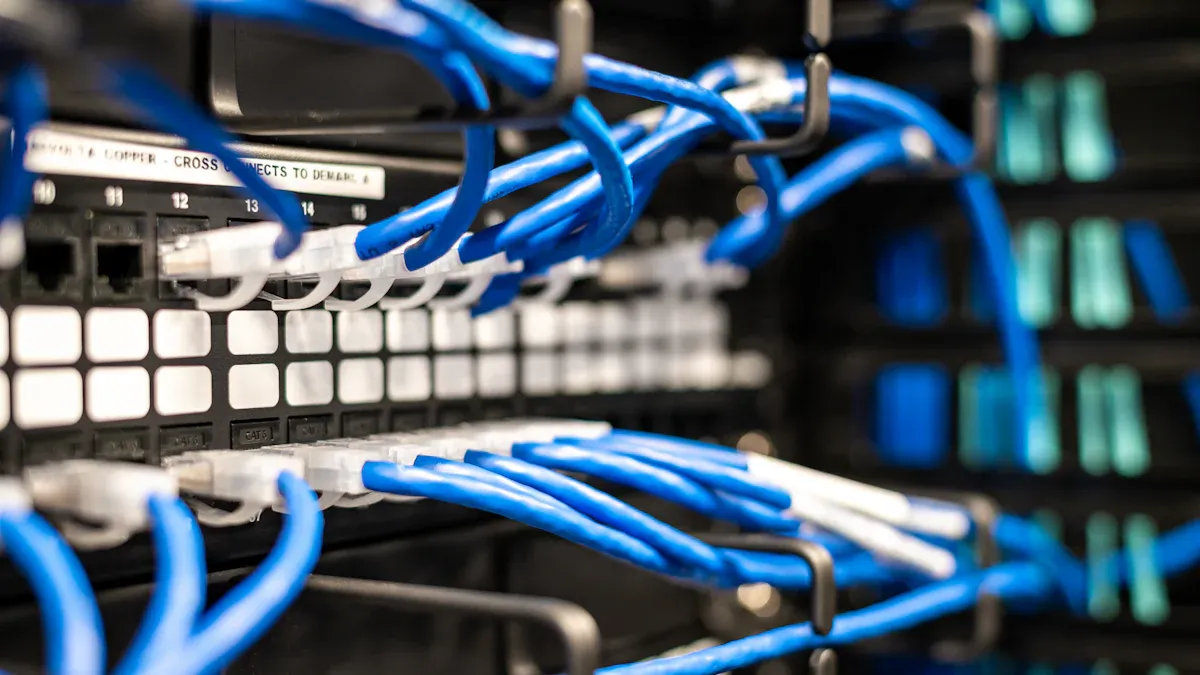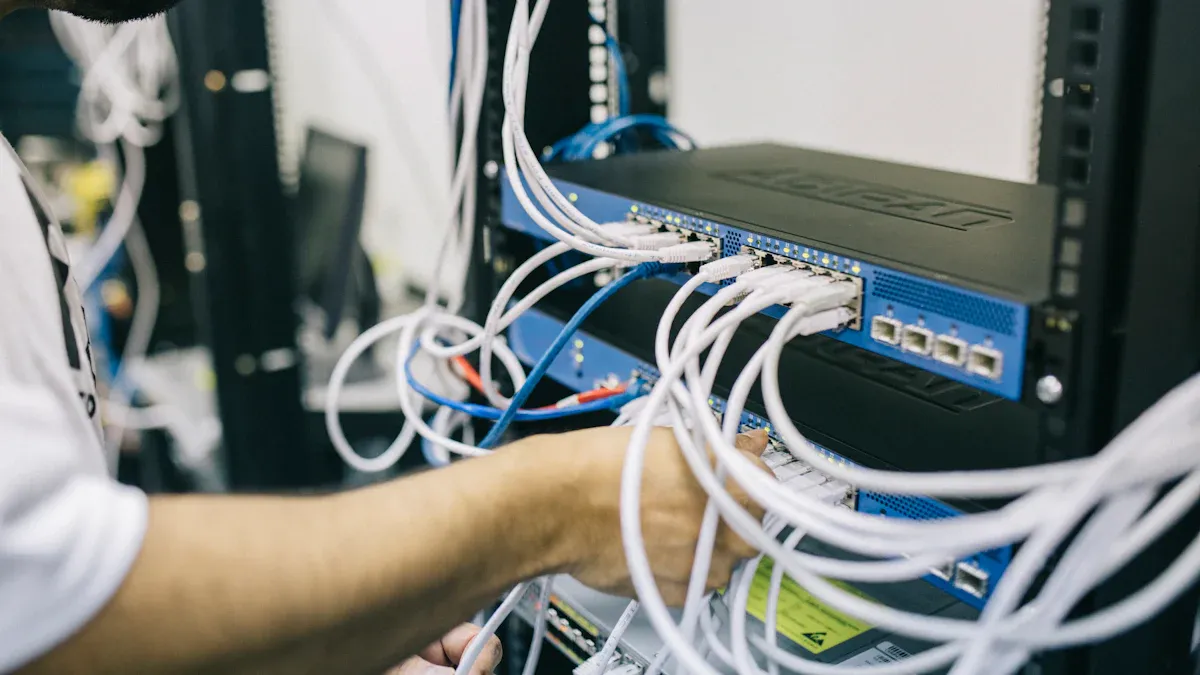Rectifier module: modular vs. integrated telecom cabinet rectifiers focusing on efficiency, cost, and maintenance

Telecom operators seeking the highest efficiency, lowest total cost, and easiest maintenance often choose the modular rectifier module. Recent industry data highlights modular designs achieving over 97% efficiency across typical load ranges, with a 30% reduction in power loss and a smaller physical footprint. Operators benefit from hot-swappable modules and simplified logistics, which reduce downtime and streamline maintenance. The modular approach also allows scalable power upgrades, making it a practical solution for dynamic network demands.
Key Takeaways
Modular rectifier modules deliver higher efficiency, reducing power loss and energy costs compared to integrated systems.
Modular designs allow easy scalability and hot-swappable maintenance, minimizing downtime and supporting network growth.
Though modular systems may cost more upfront, they save money long-term through lower maintenance, energy use, and flexible upgrades.
Maintenance is simpler and faster with modular modules, as individual parts can be replaced without shutting down the entire system.
Operators should choose modular rectifiers for dynamic, growing networks and integrated ones for stable, small-scale setups with fixed power needs.
Efficiency

Modular Efficiency
Telecom operators often select modular rectifier module systems for their superior efficiency. Modern designs, such as the Delta Eltek Modular HE DC Power System and the La Marche LMP Series, consistently achieve efficiencies exceeding 95% at 48 Vdc output. The Eltek Valere Flatpack2 HE rectifier module reaches about 96% efficiency at typical telecom loads, with peak performance near 50% load. Advanced digital control and resonant converter topologies contribute to these high ratings. Some models, like the Flatpack2 SHE, utilize CoolGaN™ technology to push efficiency as high as 98%, reducing power loss and heat dissipation by up to 50%. Modular systems also offer hot swap technology, intelligent battery management, and remote monitoring, which optimize power usage and extend battery life.
Tip: Modular rectifier modules allow operators to scale power capacity and add redundancy without system downtime, supporting dynamic network growth.
Integrated Efficiency
Integrated rectifier modules serve as a traditional solution in telecom cabinets. These systems typically operate at lower efficiency levels, often ranging from 90% to 94% at standard output voltages. Integrated designs may lack advanced features found in modular systems, such as intelligent battery management or remote monitoring. Environmental factors, including temperature and humidity, can further impact performance. Integrated units often require more robust cooling systems, especially in outdoor installations, which can reduce overall efficiency and increase energy consumption.
Efficiency Comparison
Feature | Modular Rectifier Module | Integrated Rectifier Module |
|---|---|---|
Typical Efficiency | 90–94% | |
Scalability | High (hot-swappable, expandable) | Limited |
Redundancy | Built-in, easy to upgrade | Requires full system replacement |
Power Loss | Minimal | Higher |
Maintenance Downtime | Low | High |
Modular rectifier module systems outperform integrated designs in efficiency, scalability, and redundancy. Operators benefit from reduced power loss, lower operating costs, and easier upgrades. Integrated systems may suit static environments but struggle to match the operational flexibility and energy savings of modular solutions.
Cost
Modular Cost
Telecom operators often see modular rectifier modules as a smart investment for long-term savings. These systems offer lower installation and maintenance costs due to their plug-and-play design. Operators can add or replace modules without shutting down the system, which reduces labor expenses and minimizes costly downtime. Advanced monitoring features, such as IoT and AI-based predictive maintenance, help prevent emergency repairs and lower maintenance frequency. Modular designs support redundancy configurations like N+1 or N+2, which keep networks running during module failures and further reduce downtime costs. Operators can also align capital expenditures with actual network growth by adding capacity only when needed. This staged investment approach helps manage budgets more effectively.
Note: Field studies show that high-quality modular rectifiers can cut maintenance costs by about 35% and boost uptime by 25%, directly improving operational efficiency.
Integrated Cost
Integrated rectifier systems usually have a lower upfront price. However, these savings often disappear over time. Integrated units require full system shutdowns for upgrades or repairs, leading to longer downtimes and higher labor costs. Operators face increased energy expenses because integrated systems typically run less efficiently and need more cooling. Maintenance can become complex, as technicians must service the entire unit rather than individual components. These factors drive up the total cost of ownership over the system’s lifespan.
Cost Comparison
Cost Factor | Modular Rectifier Module | Integrated Rectifier Module |
|---|---|---|
Installation | Lower (plug-and-play) | Moderate |
Maintenance | Lower (hot-swappable, modular) | Higher (system-wide repairs) |
Downtime | Minimal | Significant |
Energy Consumption | Lower (high efficiency) | Higher |
Upgrade Flexibility | High (scalable) | Low |
Total Cost of Ownership | Lower over time | Higher over time |
Modular rectifier modules may require a higher initial investment, but they deliver significant savings through reduced energy use, lower maintenance, and flexible upgrades. Integrated systems can appear cost-effective at first, but their long-term expenses often outweigh the initial savings.
Maintenance

Modular Maintenance
Modular rectifier modules simplify maintenance for telecom operators. The plug-and-play design allows technicians to replace or upgrade individual modules without shutting down the entire system. This approach reduces downtime to just minutes or seconds. Operators can manage components at the module level, which speeds up repairs and supports continuous operation even during maintenance.
Routine maintenance tasks for modular systems include:
Regular cleaning and dust removal every three to six months to prevent overheating.
Monitoring voltage and current levels with specialized tools for early issue detection.
Inspecting and tightening connections, and checking capacitors and other parts for damage.
Updating firmware quarterly to enhance performance and security.
Scheduling monthly, quarterly, and annual maintenance tasks.
Managing overheating by ensuring proper airflow and mounting.
Controlling environmental factors like moisture and temperature.
Using high-quality replacement parts for reliability.
Leveraging digital monitoring tools and predictive analytics.
Providing structured training for maintenance personnel.
Tip: Hot-swappable modules and standardized spare parts further minimize operational disruptions and simplify inventory management.
Integrated Maintenance
Integrated rectifier modules present more complex maintenance challenges. Technicians often need to power down the entire system for repairs or upgrades, which increases downtime and risk to network reliability. Common issues include power supply failures from electromagnetic interference, overheating due to blocked airflow or faulty fans, and loose or corroded electrical connections. Damaged cabling and dust accumulation can also impair performance and shorten equipment lifespan.
Operators must manage firmware and software updates carefully to avoid system malfunctions. Safety concerns require strict protocols and specialized training. Predictive maintenance tools and routine inspections help detect problems early, but repairs often demand more time and specialized expertise.
Maintenance Comparison
Factor | Modular Rectifier Modules | Integrated Rectifier Modules |
|---|---|---|
Repair Time | Minutes or seconds; no shutdown needed | Extended; full system shutdown needed |
Maintenance Costs | Lower; easy module replacement, less labor | Higher; complex repairs, more labor |
Downtime During Maintenance | Minimal or none | Significant |
Spare Parts Strategy | Standardized modules, quick replacement | Multiple specialized parts, longer wait |
Battery Maintenance | Individual module replacement | Full bank replacement |
Installation and Labor | Simpler, less time-consuming | Complex, more time-consuming |
Operators benefit from the modular approach through reduced repair times, lower costs, and minimal downtime. Integrated systems, while reliable, require more resources and time to maintain, which can impact network availability.
Decision Guide
When to Choose Modular
Telecom operators often select modular systems for environments that demand flexibility, scalability, and high reliability. Modular rectifier modules excel in dynamic networks where power requirements change frequently. Operators can add or remove modules to match evolving needs, making these systems ideal for expanding 5G networks and mission-critical sites. The plug-and-play and hot-swappable features allow technicians to perform maintenance or upgrades without shutting down the system, which minimizes downtime and supports continuous operation.
Key scenarios where modular systems stand out include:
Rapidly growing networks, such as 5G base stations and enterprise data centers.
Sites requiring high uptime (99.999%) and redundancy.
Environments where future-proofing and easy upgrades are priorities.
Locations with limited access, where quick maintenance is essential.
Installations that benefit from remote monitoring and predictive maintenance.
A modular approach also supports large-scale deployments. For example, a system with 108 modules can deliver 432kW and 8100A output, demonstrating the scalability needed for major telecom hubs. N+1 redundancy ensures uninterrupted service even if a module fails, while advanced protection features and remote monitoring enhance safety and operational flexibility.
When to Choose Integrated
Integrated rectifier modules remain a practical choice for static or smaller-scale telecom environments. Operators may prefer integrated systems when network demands are stable and unlikely to change. These systems often suit indoor installations with controlled environments, where power requirements remain consistent over time.
Situations favoring integrated systems include:
Small or medium-sized telecom cabinets with fixed power needs.
Indoor environments with stable temperature and humidity.
Projects with limited budgets that prioritize lower upfront costs.
Installations where maintenance windows can be scheduled without impacting critical services.
Operators should consider environmental factors, such as ingress protection and cooling requirements, when selecting integrated systems. Proper airflow design and grounding help reduce maintenance costs and failure rates, especially in indoor settings.
Practical Recommendations
Telecom decision-makers should weigh efficiency, cost, and maintenance priorities before selecting a rectifier module type. The following recommendations can guide the decision process:
Schedule preventive maintenance to avoid unexpected failures and reduce downtime.
Use predictive analytics and machine learning to forecast equipment issues and enable proactive repairs.
Monitor equipment status continuously and trigger maintenance only when necessary, optimizing resource use.
Prioritize maintenance activities based on equipment criticality and organizational needs to ensure cost-effective decisions.
Engage the workforce in total productive maintenance to improve operational efficiency.
Conduct root cause analysis after failures to prevent recurrence.
Utilize computerized maintenance management systems to automate and streamline operations.
Operators should also control capital expenditures carefully, monetize legacy assets, and consider strategic partnerships to unlock growth opportunities. When selecting a rectifier module, efficiency remains a critical factor. Newer technologies, such as CoolGaN™ and SiC, offer efficiencies above 96%, reducing energy loss and heat generation. Proper thermal management and system compatibility are essential for long-term reliability and cost savings.
Tip: Investing in high-quality, efficient, and reliable rectifier modules yields long-term savings and improved system performance, especially in demanding telecom environments.
Telecom operators gain significant benefits by choosing modular systems.
Modular designs offer scalability, easy maintenance, and reduced total cost of ownership.
Quick access to components, redundancy, and user-friendly interfaces minimize downtime and support long-term reliability.
Future trends highlight compact, high-efficiency modules with advanced monitoring and AI-powered maintenance.
Decision-makers should evaluate network demands, space, and growth plans to select the most effective solution for their infrastructure.
FAQ
What is the main advantage of modular rectifier modules in telecom cabinets?
Modular rectifier modules provide easy scalability and quick maintenance. Operators can add or replace modules without shutting down the system. This design reduces downtime and supports network growth.
How do integrated rectifier modules impact long-term costs?
Integrated rectifier modules often have lower upfront costs. Over time, higher energy use and complex maintenance increase total expenses. Operators may face more downtime and higher labor costs.
Can operators upgrade modular rectifier systems without service interruption?
Yes. Operators can upgrade modular rectifier systems by adding or swapping modules while the system remains online. This feature ensures continuous network operation and minimizes service disruption.
Which rectifier type offers better redundancy for critical sites?
Modular rectifier modules offer superior redundancy. Operators can configure N+1 or N+2 setups. If one module fails, others continue to supply power, ensuring uninterrupted service for critical sites.
Are modular rectifier modules suitable for small telecom installations?
Modular rectifier modules can fit small installations. However, integrated systems may suit sites with stable, low power needs and limited budgets. Operators should assess network demands before choosing a solution.
See Also
Analyzing The Design And Expenses Of Telecom Cabinets
Steps To Guarantee Stable Power For Telecom Cabinets
Integrating Solar Inverters And Batteries With Telecom Cabinets
Exploring Various Applications Of Telecom Cabinets Today
Methods To Calculate Power Systems And Batteries For Telecom
CALL US DIRECTLY
86-13752765943
3A-8, SHUIWAN 1979 SQUARE (PHASE II), NO.111, TAIZI ROAD,SHUIWAN COMMUNITY, ZHAOSHANG STREET, NANSHAN DISTRICT, SHENZHEN, GUANGDONG, CHINA

